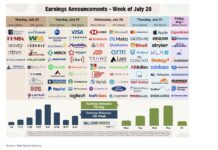 by Greg Naylor September was an uneventful month for US economic data, as well as the global capital markets. Stocks drifted higher after the Fed non-tapering ‘surprise’, but all eyes remained fixated on the upcoming deficit ceiling and budget impasse.
by Greg Naylor September was an uneventful month for US economic data, as well as the global capital markets. Stocks drifted higher after the Fed non-tapering ‘surprise’, but all eyes remained fixated on the upcoming deficit ceiling and budget impasse.
Here is what happened in the capital markets, along with a look at key US economic data. By the numbers:
Stocks & Bonds
After a selloff in August, September saw a rally on the heels of continued Fed stimulus. Bonds reversed some of their losses, although generally speaking they are still ‘in the red’ year-to-date.
| S&P 500 Total Return | MSCI EAFE | BarclaysAggregateBond | Unadjusted CPI | |
| September | 3.13% | 5.66% | 0.95% | 0.12% |
| August | -2.90% | -0.23% | -0.51% | 0.04% |
| YTD 2013 | 19.79% | 13.34% | -1.89% | 1.58% |
Commodities & Currencies
NYMEX crude lost 4.44% in September, down to $102.33 per barrel, and is up 9.47% year-to-date. Gold declined 4.95% to a close of $1,327.00 per ounce. For the most part commodities saw declines in September, with corn and soybeans down 10.46% and 9.58%, respectively. The dollar index declined in September by 2.28%, leaving it almost unchanged year-to-date. Often when the dollar declines, it is associated with rising commodity prices, so September was modestly unusual since both commodity prices and the U.S. dollar saw declines.
US Economic Data – The Economy at a Glance
The Labor Department will not report on the unemployment rate for September, due to the government shutdown. It likely has not changed much from August’s 7.3%. The Institute for Supply Management had surprisingly good news, reporting that September’s manufacturing PMI rose to 56.2, from the previous month’s 55.7, indicating continued expansion in the manufacturing sector.
The National Association of Realtors (NAR) reported that the annual rate of existing-home sales in August increased by 13.2% from August 2012. National median prices rose from the prior year by 14.7% to $212,100. Foreclosures and short-sales, as a percentage of overall sales, continued to drop, and were at 12% of overall sales, a new multi-year low.
Summary
Most eyes are focused on the current government shutdown, and its possible economic effects. To mix things up a little, let’s look at how our cousins in Europe are faring. “Unemployment in the 17-nation euro area remained at a record high of 12.1 percent in August, according to the median estimate of 30 economists in a Bloomberg News survey.” Also, “Gross domestic product in the 17-nation euro economy grew 0.3 percent in the three months through June, the first quarterly expansion after six contractions.” Wow. Those statistics make our own unemployment and GDP rates look downright robust (7.3% and 2.5%, respectively, as of the most recent government reports). In turn, Europe looks relatively healthy compared to some others. India’s currency, the rupee, has dropped about 14% against the U.S. dollar since the beginning of the year. India’s foreign reserves are also declining precipitously, and official inflation is running at 9.52%. They are not alone among developing nations, which are struggling with weak commodity prices and often high inflation.
So, although I worry about the U.S. economy, we could be doing a lot worse.
This material was prepared by Greg Naylor, and does not necessarily represent the views of Woodbury Financial or its affiliates. This information should not be construed as investment, tax or legal advice and may not be relied upon for the purpose of avoiding any Federal tax liability. This is not a solicitation or recommendation to purchase or sell any investment or insurance product or service, and should not be relied upon as such. The S&P500, MSCI EAFE and Barclays Aggregate Bond Index are indexes. It is not possible to invest directly in an index. Investing involves risks and investors may incur a profit or a loss. Past performance is not an indication of future results. There is no guarantee that a diversified portfolio will outperform a non-diversified portfolio in any given market environment. No investment strategy can guarantee a profit or protect against loss in periods of declining values.
Data Sources:
- www.standardandpoors.com – S&P 500 information
- www.msci.com – MSCI EAFE information
- www.barcap.com – Barclays Aggregate Bond information
- www.bloomberg.com – U.S. Dollar & commodities performance
- www.realtor.org – Housing market data
- www.bea.gov – GDP numbers
- www.bls.gov – CPI and unemployment numbers
- www.commerce.gov – Consumer spending data
- www.napm.org – PMI numbers
- www.bigcharts.com – NYMEX crude prices, gold and other commodities
- https://data.bls.gov/timeseries/LNS11300000 – Labor participation data
- https://www.bea.gov/newsreleases/national/pi/pinewsrelease.htm – PCE reference numbers
- https://www.cnbc.com/id/100877586 – Bernanke comments
- https://www.bloomberg.com/news/2013-09-29/europe-s-record-jobless-rate-seen-resisting-recovery.html – Unemployment rate in Europe
- https://www.foxnews.com/world/2013/09/30/india-quarterly-current-account-gap-widens/ – Data on rupee
- https://www.bloomberg.com/news/2013-09-26/rajan-seen-switching-main-rbi-price-gauge-in-sign-of-rate-rises.html – CPI in India
About Greg Naylor: Greg is a partner and co-founder of Fiat Wealth Management, an independent financial advisory firm in Long Lake, Minnesota. He has been investing for over 7 years and enjoys sports, reading, singing, and spending time with family. Greg is a 2004 graduate of the University of Minnesota and lives in South Minneapolis with his wife Kat.
Any opinions expressed herein are solely those of the author and do not in any way represent the views or opinions of any other person or entity.








